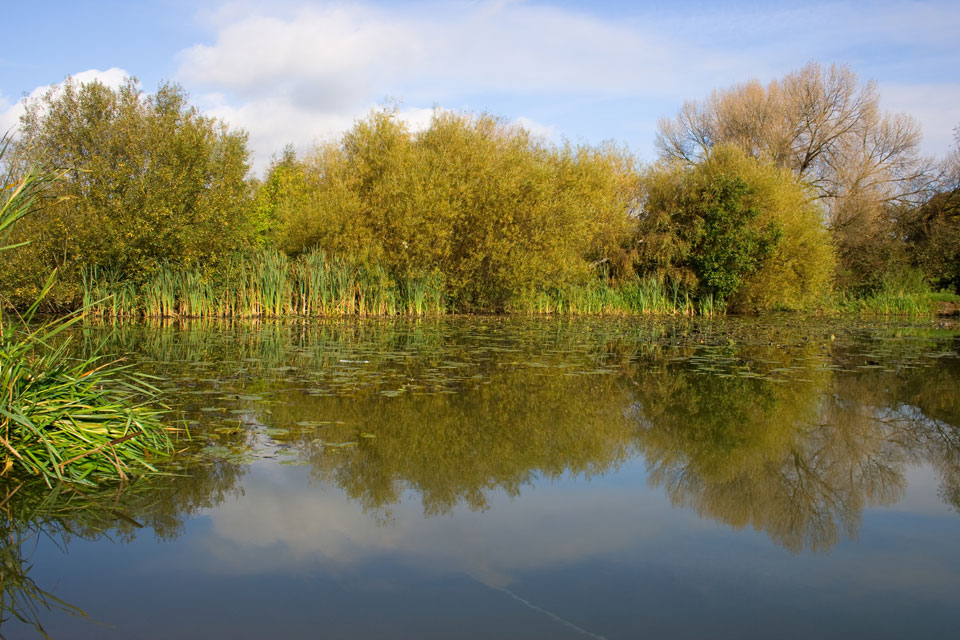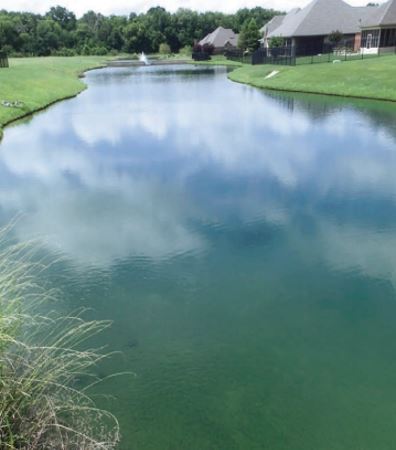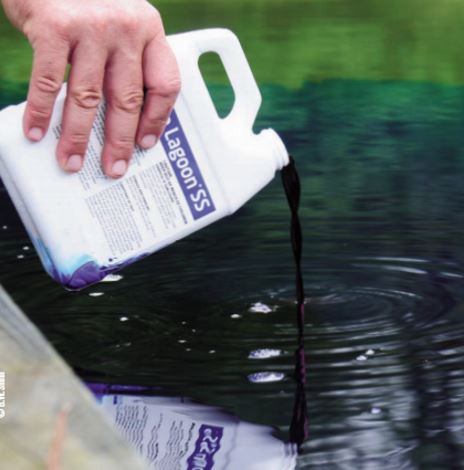Barry W. Smith | Originally published in GameKeepers: Farming for Wildlife Magazine

Many of you have seen small ornamental ponds that look like the water was imported from the Caribbean; a deep emerald blue color. This color, of course, was a result of a blue colorant or pond dye. Although blue is a very common color for pond dyes, black is also used to produce a more natural color. Many of you that watch golf on television have seen ponds on golf courses that have been treated with a black dye. This dye often produces a color that gives the appearance of a deep and dark lake. The black dye usually produces a dark tea or tannic acid color.
Black dye is used in the ponds at the Augusta National, where the Masters is played and on many other golf courses. All dyes act in a similar manner as they block sunlight penetration and impart a color to the pond. For some lake owners, color or esthetics is an important consideration for their pond. There are some advantages and a few disadvantages in using dyes or colorants.
Pond Dyes Can Limit Plant Growth
In the Southeast, most recreational fishing lakes are managed for fish production. An important part of that management protocol is lake fertilization. A good pond fertilization program can triple the production of fish food and consequently sport fish as compared to an unfertilized pond or lake. Fertilization creates a phytoplankton bloom, which is a population of many single-cell plants that provide the basis of the aquatic food chain and also provide oxygen through photosynthesis. Pond dye can reduce the production of phytoplankton and often reduce the production of sport fish.We attempt to maintain a “bloom” of 18 to 24 inches with a fertilization program and this blocks sunlight penetration to areas deeper than 24 inches. This will effectively shade much of the pond bottom, discouraging the production of aquatic plants and filamentous algae. Pond dyes and colorants can have the same effect if used in high enough concentrations to block sunlight from reaching the pond bottom. You can discourage weed growth using dyes, but also decrease the plankton or food production in your lake.

attempt fertilization, as this will increase plant growth.
In some cases, pond dyes can be useful to limit plant
growth.
Once plants or filamentous algae have become established, it is not wise to attempt fertilization, as this will make the plant growth increase. In some of these cases, pond dyes can be useful in limiting plant growth. There is only one pond dye that is registered with the EPA for aquatic plant growth control. However, all other dyes work on the same principle of blocking sunlight and can have the same effect if used at proper concentrations.
We have seen lakes that are clear and have aquatic weed growth as deep as four to seven feet. In situations similar to these, pond dyes can be effective in blocking sunlight penetration and controlling growth of these deep growing plants.
Application Rates: How to Use Pond Dye
Pond dyes are sometimes marketed as “concentrated” and stating that one quart is equivalent to one gallon. According to Tom Warmuth of Cygnet Enterprises, you should typically apply a gallon of dye for every 4 acre-feet. He suggests measuring the visibility of the lake approximately two days after application. This can be accomplished by lowering a Secchi disc or a stick with a piece of white plastic on the end, to a depth where it disappears from sight. This would then be the depth at which sunlight penetration is blocked. If the water visibility is greater than three feet, add more dye until you achieve the desired depth for weed control.
Warmuth says that most pond owners add enough dye to achieve a color change but often not enough to help with weed control. He says that dye can be effective in controlling deeper growing weeds and algae, but often is ineffective in preventing algae growth in shallow water, herbicides are recommended in those situations.
How Long Does Pond Dye Last?
Retention of dye depends a lot on how much water exchange occurs in the pond. Lakes or ponds that have a constant flow of water can expect to lose their color much faster than lakes which are static. Warmuth says that in a typical pond without a large watershed or constant flow, dye will remain effective for weed control for four to six weeks. “If you use blue dye,” Warmuth says, “some of the blue pigments will remain in the water much longer than black pigments and still produce a blue tint in the water. However, the visibility will be greater than you think and the dye will not be effective in preventing most weed growth.”

visibility and add dye frequently to maintain the desired level of light
penetration. Remember however, that some phytoplankton is
desirable for the production of oxygen, so don’t get the water too
dark.
The key to using dyes to manage some aquatic plants is to monitor the visibility and add dye frequently enough to maintain the desired level of light penetration. This can be achieved with both blue and black dyes. To those who think if a little is good, a lot is better; please remember that some phytoplankton is desirable for the production of oxygen through photosynthesis … don’t get the water too dark!
Pond Dye Application Techniques
Dye may be applied by gently pouring from the container directly into the pond. A few words of caution: the concentrated dye will color you, your clothing or anything it contacts before it is mixed with the pond water. It is suggested that you use latex gloves when handling the containers and do not pour from a height that will cause the concentrated dye to splash. In small ponds less than an acre, wind currents will quickly disperse the dye throughout the pond.
Always pour with the wind at your back, so the wind currents can carry the dye across the pond. In larger lakes, the dye can be poured into the current produced by an aerator or diffuser. Dye can also be poured from a boat into the prop current from an electric or gasoline motor. Use caution not to spill dye into your boat, as this can be very messy.
Once the dye is mixed with the pond water, it will not stain your pets, fish or plants. Dye is nontoxic and will not harm any aquatic life or animals that drink the water. Pond dyes can be very useful in limiting the growth of aquatic plants in certain circumstances. You may contact your local fisheries biologist or American Sport Fish in Montgomery, Ala. to determine if your lake is a candidate for pond dye.































